#software resources
Explore tagged Tumblr posts
Text
Pencil/2D Animation Resources Masterpost
5/10/24:
Hello, I broke into my old account so I could make a little masterpost of resources I come across for learning pencil/2D animation. (Free or affordable classes, places to get tools, videos to give insider insight, etc.) I may not be able to get everything included, so if you think of something, you can reach out and suggest things to add! I will be updating this over time, with notes on when it was last recently updated. And maybe I'll end up giving the old blog a refresh too. I likely won't be making new masterposts outside of this one any time soon, nor updating any old ones. It's been SEVERAL years, and the internet is a different place. I would assume most of the old links are out of date by now, unfortunately. I hope that this list is helpful to you as well, and if I'm incorrect in anything I list, I'm learning too! So please be patient with me and feel free to reach out with a correction. It's not finished yet, but Tumblr deletes my posts before I finish them, so I'm starting with posting the skeleton and slowly updating this)
Find a Community to Learn From!
(recommended groups to lurk/join/make connections and ask questions)
What Tools Do I Need?
PDF Guide to Animation Desks, as written by David Nethry
(next line)
Where Do I Get Tools?
(Places where you can buy art supplies, software, etc)
Cartoon Supplies
(Online seller who carries Ingram Bond paper, lightboxes, storyboard pads, blank cels, etc. See also: Lightfoot LTD, which is identical in every way to Cartoon Supplies and for the life of me I'm not sure the difference, though both are equally recommended along side each other.)
Jet Pens
(Ah... I love window-shopping this site. If you love stationary like I do, you'll be on this site for hours adding things to your cart... and inevitably removing them because it's not feasible to spend hundreds on pens and sticky-note pads.)
Dickblick
(I've found they have good prices on name brands, but I haven't purchased from them yet. Often, I'm too overwhelmed by all the choices.)
Improve Your Art/Learn the Basics!
(anatomy classes, starter tools, etc)
Aaron Blaise (Co-Director of Brother Bear)'s Online Classes
He runs very good deals on the classes occasional, but you can also do a year's access to all classes and keep what you download, which is very useful! They're short, quick lessons, and tend to veer into more "helpful tips" than teaching, from what I've personally noticed, but it's well worth the price if you get them at a good deal!
Inside Look at the Industry -- aka: the Special Features:
(behind the scenes stuff, etc)
Books are more useful than you might think!
(Richard Williams Animator's Survival Toolkit, etc) (check out gently used copies of these books on Thriftbooks for a good deal!)
Nifty Free Resources
(Things like height charts, references, color wheels, blog posts, videos, etc)
What Artists Can Learn From Aladdin's Incredible Color by J. Holt [VIDEO]
(spacing for formatting)
The Art of Color Theory: Guide for Animators, Designers, and Artists (Animator Artist Life)
(space for formatting)
Free software!
GIMP
(A classic, GIMP is an old friend of mine. The first software I downloaded for art, I used to use it almost entirely to create animated GIFs for the Warrior Cat forums. Ah, how time has passed. Nowadays I can't even remember how to animate a GIF on there, but such is life. I still use it to this day for digital art, even having Corel Painter. Before GIMP, I animated the old fashioned way -- MS paint and Windows Movie Maker. With determination, I scripted and animated a handful of Warrior Cat characters frame by frame. Each frame of Hollyleaf or whoever it was blinking was the likely source of death for our old computer, may she rest in peace.)
Storyboarder
(Storyboarder is a free software with which you can use to create professional and clean storyboards. It also provides printable storyboard templates so you can do you work traditionally and re-upload it easily into the software! It also works with Wacom tablets. Check it out! It's actually super cool.)
Pencil 2D
(A free, open source software. Simplistic design, switch between raster and vector, and best of all, again, it's free. I haven't used this one much yet, but I've seen it positively talked about by many! I'll update with more research when I have the chance.)
Krita
(I haven't used this one yet, so I can't speak on it either! But it's going on the list so I can come back and research it later. My poor laptop is not going to handle this many downloads lol.)
OpenToonz
(I also haven't tried this, but see above, haha.)
Blender - Grease Pencil
(Blender is well known for 3D animation, but they added a 2D feature called Grease Pencil as well.)
WriterDuet
(Free for up to 3 projects, very simple, but upgrades to a $10 a month plan, which is... eh, I'll keep my Scrivener for now. I used to write scripts in Microsoft Word or the Notepad on PC back in the day, I don't think I personally need the fancy features.)
Trelby
(A free screenwriting software, very basic and simple, good for beginners.)
Keep an eye out for
(Humblebundle occasionally does software deals -- a good art bundle at a discount can give you an easy start!)
#animation#wip#animation resources#art resources#free software#software resources#art tools#animation tools#how to#how to art#how to animate#animators on tumblr#2d animator#animation masterpost#masterpost#masterposts
25 notes
·
View notes
Text
Other Words for "Look" + With meanings | List for writers
Many people create lists of synonyms for the word 'said,' but what about the word 'look'? Here are some synonyms that I enjoy using in my writing, along with their meanings for your reference. While all these words relate to 'look,' they each carry distinct meanings and nuances, so I thought it would be helpful to provide meanings for each one.
Gaze - To look steadily and intently, especially in admiration or thought.
Glance - A brief or hurried look.
Peek - A quick and typically secretive look.
Peer - To look with difficulty or concentration.
Scan - To look over quickly but thoroughly.
Observe - To watch carefully and attentively.
Inspect - To look at closely in order to assess condition or quality.
Stare - To look fixedly or vacantly at someone or something.
Glimpse - To see or perceive briefly or partially.
Eye - To look or stare at intently.
Peruse - To read or examine something with great care.
Scrutinize - To examine or inspect closely and thoroughly.
Behold - To see or observe a thing or person, especially a remarkable one.
Witness - To see something happen, typically a significant event.
Spot - To see, notice, or recognize someone or something.
Contemplate - To look thoughtfully for a long time at.
Sight - To suddenly or unexpectedly see something or someone.
Ogle - To stare at in a lecherous manner.
Leer - To look or gaze in an unpleasant, malicious way.
Gawk - To stare openly and stupidly.
Gape - To stare with one's mouth open wide, in amazement.
Squint - To look with eyes partially closed.
Regard - To consider or think of in a specified way.
Admire - To regard with pleasure, wonder, and approval.
Skim - To look through quickly to gain superficial knowledge.
Reconnoiter - To make a military observation of a region.
Flick - To look or move the eyes quickly.
Rake - To look through something rapidly and unsystematically.
Glare - To look angrily or fiercely.
Peep - To look quickly and secretly through an opening.
Focus - To concentrate one's visual effort on.
Discover - To find or realize something not clear before.
Spot-check - To examine something briefly or at random.
Devour - To look over with eager enthusiasm.
Examine - To inspect in detail to determine condition.
Feast one's eyes - To look at something with great enjoyment.
Catch sight of - To suddenly or unexpectedly see.
Clap eyes on - To suddenly see someone or something.
Set eyes on - To look at, especially for the first time.
Take a dekko - Colloquial for taking a look.
Leer at - To look or gaze in a suggestive manner.
Rubberneck - To stare at something in a foolish way.
Make out - To manage to see or read with difficulty.
Lay eyes on - To see or look at.
Pore over - To look at or read something intently.
Ogle at - To look at in a lecherous or predatory way.
Pry - To look or inquire into something in a determined manner.
Dart - To look quickly or furtively.
Drink in - To look at with great enjoyment or fascination.
Bask in - To look at or enjoy something for a period of time.
#on writing#creative writing#writing#writing tips#writers block#how to write#thewriteadviceforwriters#writeblr#writers and poets#writers on tumblr#novel writing#fiction writing#romance writing#writing advice#writing blog#writing characters#writing community#writing help#writing ideas#writing inspiration#writing guide#writing prompts#writing a book#writing resources#writing reference#writing tips and tricks#writers#writing tools#writing life#writing software
17K notes
·
View notes
Text
























misc coding stamps graphics
#carrd#carrd resources#carrd stuff#neocities resources#webcore#neocities#website#stamps#neocities stamps#2000s#old web graphics#web graphics#web resources#software#coding#javascript#c++#python#html css#rentry decor#rentry#rentry graphics#old web
4K notes
·
View notes
Text
No-Google (fan)fic writing
After this post about Google automatically enrolling everyone into their AI program (including reading Google docs), I realised that many people may not be aware that there are actually very, very good alternatives to using Google docs – although what they can do for you varies.
So, since I’ve over the years tested quite a lot of different applications for usefulness in writing fanfic, I thought I’d share some of my experiences here. The link list below will be expanded as I continue writing more pieces, so keep checking here.
Part 1: LibreOffice Writer
Part 2: Zettelkasten
Part 3: LaTeχ
Part 4: Markdown
Part 5: Obsidian
Note: I updated some of the posts with screenshots of the interfaces for illustration purposes. You might want to reblog those again.
#fanfiction#fic writing#resources#degoogle#degoogle your fics#degoogle your writing#software recommendations#no-google (fan)fic writing#fanfic writing
282 notes
·
View notes
Text
Writing Software I Use & Recommend
Brainstorming:
Campfire: Great for organising your thoughts and making detailed character profiles, customised maps, worldbuilding, plot organisation—amongst other features. You can write your manuscript here and post it; and they have many helpful writing tips on their blog. Here's a general overview (customisable):
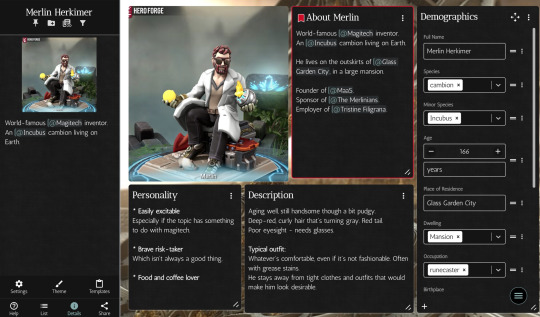
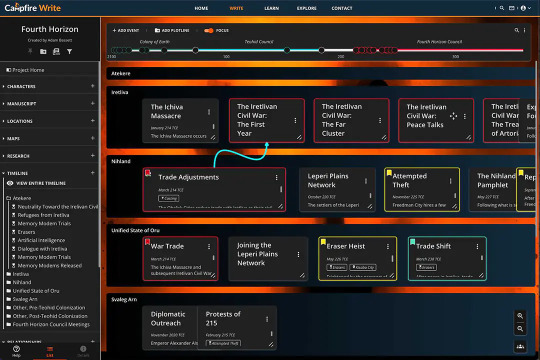
Notion: Although not conventionally a writing software, I find it immensely helpful for getting my thoughts sorted out. It's organised and easy to navigate, and the interface is manageable and uncluttered. (Keep in mind it's hard to cowrite on Notion—if you're planning to, I suggest making a separate Gmail account and both logging in with that.)
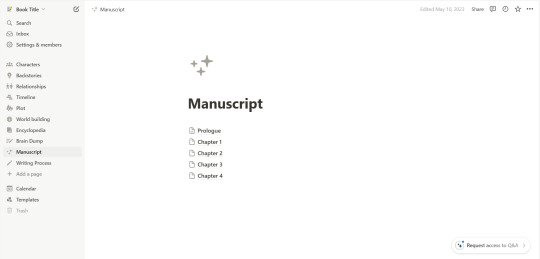
Microsoft Word, with spellcheck off, in Comic Sans (I saw the font thing somewhere and hate that it works). This is what I use when writing excerpts or spontaneous ideas, and it's actually quite effective, though I couldn't tell you why.
Writing/Editing:
Reedsy: The manuscript editor is organised and lets you set writing goals, split chapters, and jot down notes for later. I highly recommend it for authors looking to self-publish—once you're done, you can format and export your book as an eBook or PDF; and you can connect with various editors and find the one that's right for your novel.
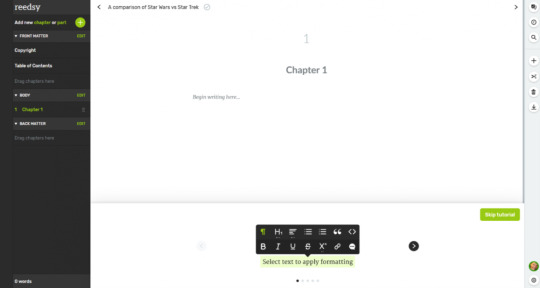
Scrivener: Although, unlike the others I've mentioned so far, this software isn't free, the formatting is great for making an outline, collecting any research and notes, and writing your manuscript.
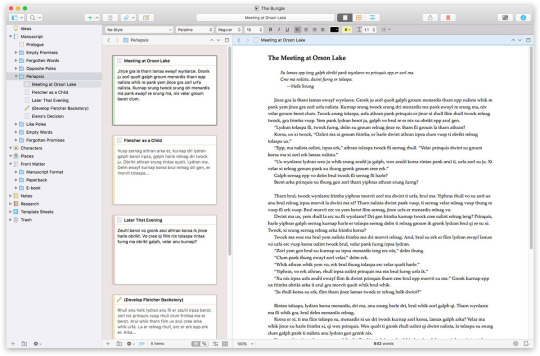
Feel free to add on any more you know of! Hope this was helpful ❤
Previous | Next
#writeblr#writing#writing tips#writing advice#writing help#writing resources#creative writing#writing software#writer stuff#writer help#writing inspiration#deception-united
952 notes
·
View notes
Text
i have scraped culpepers compleat physician and made a database of the plants mentioned and their planetary associations as given in the text.
it is available as a single html page for offline reference in a browser:
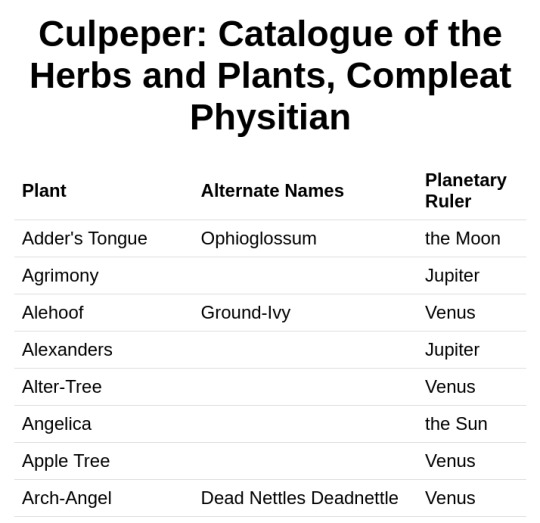
and JSON (more formats soon) on github:
198 notes
·
View notes
Note
Do you know a good app or any other procedure/materials where I can make a structure of my long form story? :( i basically don't know how to map it all out.
Here's a great post by @the960writers
LibreOffice (https://www.libreoffice.org/)
FocusWriter (https://gottcode.org/focuswriter/)
Scrivener (https://www.literatureandlatte.com/scrivener/overview)
Reedsy (https://reedsy.com/write-a-book)
Novelpad (https://novelpad.co/)
Campfire (https://www.campfirewriting.com/)
Obsidian (https://obsidian.md/)
Notesnook (https://notesnook.com)
Ellipsus (https://ellipsus.com)
Read their full post for more information. Hope this helps :)
#anonymous#writing app#writing tool#writing software#writeblr#writers on tumblr#writing reference#dark academia#spilled ink#creative writing#fiction#light academia#writing resources
158 notes
·
View notes
Text
There’s a whole slew of writing software geared towards motivation, organization, and curing writer’s block.
Not to say that writing software and other writer frills aren’t cool as hell, or don’t have a purpose. If it works, it works. But…
Please know that all you need is Notepad and a folder of organized text files.
All you need is a pen and a notebook.
All you need is your ideas and a way to put them down SIMPLY. Especially for the first time.
You don’t need a specific font, or an AI editor, or Word’s fucking squiggly-line suggestions, or formatting capabilities, etc.
You need you and a minimalist approach to a zero draft, without the distractions people sell.
I promise it will work out.
#writing#reading and writing#creative writing#writing community#fiction writing#writing software#writing stuff#on writing#writers community#writer thoughts#writing and writers#writers on writing#writers#how to write#write#writers on tumblr#writer problems#writer stuff#cashmere ink#writerblr#writers block#writerscommunity#writers and poets#writeblr#writer things#writing resources#writing motivation
39 notes
·
View notes
Text


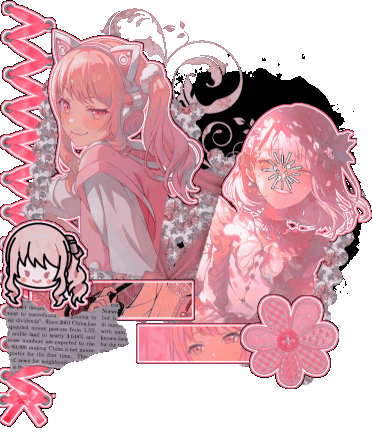
" I'm still me, but is that ok? "
Mizuki Akiyama graphics!
Psd by @/koebi!
Mizuki renders by @/sekaitransparents!
- credits not needed, but appreciate!
- Also rb appreciate it!

Tagging moots :3
@heavenlygard3n @swizzele
(I have two but anyone wants to be my moot...?)

#─ ʚ dollives edits ɞ . ♫#─ ʚ dollives's graphics ɞ . ♫#pjsk#project tracking software#rentry graphics#rentry resources#rentry inspo#rentry decor#rentry layouts#mizuki akiyama#akiyama mizuki#mizuki pjsk#carrd graphics#looking for moots#i need moots#miau
26 notes
·
View notes
Text
How do you "bookmark" posts on Tumblr?
Bookmark as in, saving a post in a place that you can easily access later in case you want/need to look at it. Posts like resources, references, links, tutorials (to name a few)... Anything you might want to save for later.
I am curious! I personally reblog them into the Drafts but I'm aware people do it differently.
#tutorial posts like how to eliminate windows annoying functions#or references like meme templates or poses#or resources like free office-like software or free art programs etc#polls
14 notes
·
View notes
Text
Wix Learn's Free Web Accessibility Certification | Resources ✨

Hiya! 💗 Today, I stumbled upon an absolute gem that I wanted to share with all of you. If you're learning about web design and inclusivity as I am, this is something you might want to look into~!
Introducing the Web Accessibility Course by Wix Learn - a game-changer for anyone striving to create websites that cater to all users, regardless of impairments. This comprehensive course covers everything you need to know to build an inclusive online space that leaves no one behind. AND IT COMES WITH AN EXAM AND CERTIFICATE (all free too hehe).
In this course, you'll gain mastery over essential skills, including:
🌐 Creating Inclusive Sites: Learn the best practices to make your websites accessible to people with various impairments, ensuring equal access for everyone.
📚 Accessible Title Tags and Headings: Dive into the world of proper title tags and heading structures, making navigation a breeze for every visitor.
👁️🗨️ Crafting Alt Text and Alternative Media: Discover the art of writing meaningful alt text and incorporating alternative media, providing a seamless experience for those with visual challenges.
⚙️ Optimizing Navigation for Assisted Technology Users: Enhance site navigation for individuals relying on assisted technologies, making their browsing experience smooth and efficient.
💬 The Power of an Accessibility Statement: Learn to create a compelling accessibility statement, showcasing your dedication to inclusivity and informing visitors about your website's accessibility features.
They even have prep courses for the exam! 🤗✨
Here's the link to the course: LINK
Hope this helps someone out there, I will be trying it out and seeing how it goes! 👍🏾
#resources#web accessibility#coding#codeblr#programming#progblr#studyblr#studying#tech#software developer#comp sci#programmer#learning to code#webdesign#web design#web development
288 notes
·
View notes
Text

🤍 the cure to all my ailments 🤍
#jinki art is BACK on this blog (back back back)#my drawing tablet was happy to come out of its drawer for a change#should I tag this as *not an edit*?#I've been toning down on the hyper-realism lately but I never know if it will confuse folks lol#anyway#I'm overwhelmed with excitement#he looks so goooooood#lee jinki#ThatGoodOldArtTag#onew#shinee#(I wish I'd had time to glaze and nightshade this but it was taking foreveeeer to download the resources and unzip and setup the#whole thing and I really need to go to bed cause these days I'm working like crazy and it's been stressful#so perhaps the next time I'll have more time to setup these softwares and make them work) *sigh*#shinee shenanigans
86 notes
·
View notes
Text
Character Flaws and Their Meanings
Impulsiveness : Acts on instinct without careful planning. Perfectionism : Sets unrealistically high standards, leading to self-criticism. Indecisiveness : Struggles to commit to decisions or choose a path. Arrogance : Overestimates one’s abilities and dismisses others. Pessimism : Habitually expects negative outcomes in most situations. Cynicism : Distrusts the motives and sincerity of others. Overconfidence : Places excessive faith in one’s skills, often underestimating risks. Stubbornness : Resists change and refuses to adapt to new ideas. Jealousy : Feels envious of others' success or possessions. Insecurity : Experiences frequent self-doubt and a lack of confidence. Procrastination : Tends to delay tasks, often leading to missed opportunities. Passivity : Avoids taking initiative and relies on others to act. Aggressiveness : Responds with hostility or force rather than reason. Selfishness : Prioritizes personal gain over the welfare of others. Fragility : Is overly sensitive to criticism and easily discouraged. Egotism : Constantly focuses on oneself and one’s own importance. Defensiveness : Quickly rejects or rationalizes away critique or new information. Manipulativeness : Exploits others to fulfill personal needs or desires. Recklessness : Shows a careless disregard for potential risks or consequences. Resentfulness : Holds lingering bitterness and grudges over perceived wrongs. Distractibility : Finds it hard to maintain focus amid competing interests. Impatience : Lacks the willingness to wait, often spoiling opportunities to learn. Perfunctory : Performs actions in a mechanical, uninspired manner. Self-Doubt : Consistently questions personal abilities and decisions. Arbitraryness : Makes decisions based on whim rather than reason or evidence. Rigidity : Is inflexible and unwilling to consider alternative viewpoints. Gullibility : Trusts too easily, often leading to being misled or deceived. Obsession : Becomes excessively fixated on particular ideas or details. Aloofness : Maintains emotional distance, appearing detached or indifferent. Intolerance : Refuses to accept differing perspectives or lifestyles.
Writing Advice for Brainstorming
Mix genres and time periods: Experiment by combining elements from different eras or genres to create unique settings and narratives.
Use "what if" scenarios: Pose unexpected questions (e.g., What if time travel operated on emotions rather than mechanics?) to spark novel ideas.
Draw from diverse mediums: Engage with art, music, or even scientific papers to inspire unexpected plot twists.
Embrace absurdity: Let illogical or surreal ideas guide you; sometimes the wildest thoughts lead to compelling stories.
Reverse clichés: Identify common tropes in your favorite genres and deliberately invert them to create fresh perspectives.
Incorporate personal anomalies: Transform your idiosyncrasies and personal struggles into rich, multi-dimensional characters.
Use mind-mapping: Visually plot your ideas in a freeform way to uncover hidden connections between disparate elements.
#writing#writeblr#on writing#writing tips#how to write#writers block#creative writing#writers and poets#thewriteadviceforwriters#writers on tumblr#writing project#fiction writing#novel writing#writing a book#writing advice#romance writing#writing characters#writing community#writing guide#writing inspiration#writing prompts#writing ideas#writing reference#writing blog#writing resources#writing help#writing software#writerscommunity#writers#writing tips and tricks
9K notes
·
View notes
Text

USA 1993
#USA1993#BUENA VISTA SOFTWARE#SOFTWARE RESOURCES INTERNATIONAL#PUZZLE#IBM#MACINTOSH#FM TOWNS#HEAVEN & EARTH
13 notes
·
View notes
Text
No-Google (fan)fic writing, Part 2: Zettelkasten
Storytime
Word and Writer (see this post) used to have one huge disadvantage – the number of pages either of them were capable of keeping in active memory before the whole thing would just crash. This was, of course, in part because computers had less RAM in those days, but also because Word and Writer constantly keep everything you write available in exactly the layout it will be printed as. Or, to use slightly more computer-y language, both of them are “What You See Is What You Get” (WYSIWYG).
That also means that if you start using certain features – lots of headings, footnotes, images especially – they quickly reached their capacity. I had one document consistently crash at 100 pages, although usually, it would take up to 300 pages before that happened.
Nonetheless, it was frustrating, also because the crashing meant that documents would get corrupted and I would lose what I had written. Yes, corrupted documents are a real issue. Especially because Word’s source code is protected, so it’s not easy to recover them.
Also annoying was the “having to split up documents into several files”.
But the worst part, for me, was that I lost some really good stuff because I was rearranging the order of scenes and forgot to paste before cutting another scene, and didn’t notice in time.
So I went looking for other options. How I ended up finding Zettelkasten is a mystery today, but I did.
Word/Writer/Google docs versus Zettelkasten
So what is Zettelkasten?
Many notes, one story
Well, if you have heard of Scrivener, that would be an equivalent. The principle is fairly easy – every new thought/idea/scene is created as a “note”, which is added to a growing collection of other “notes”. That means you can keep different scenes separate and work on them individually without always opening the whole document, which, given the crashing problems mentioned above, definitely a +1.
Features
It is also easier to rearrange the order of scenes without losing anything, because Zettelkasten has a virtual “desk”, on which you can place your notes. This “desk” can be divided into chapters, sections and subsections, basically small “folders” that you keep all the scenes for a specific story in, in the order you want. They can be moved up and down, to different chapters, or entirely removed from the desk. That’s important to note, because it doesn’t mean you’re deleting the note completely. Even if you accidentally delete a scene from this desk, the note will still be there, so you can simply add it again, no harm done.
+1 for organisation and another +1 for not having to be afraid of losing stuff.
Additionally, Zettelkasten lets you tag every note. I had tags for characters, so each note would be tagged with the characters appearing in that particular scene, but you can create tags as you like. This also allows you to search specifically for scenes with certain characters involved, which is useful because I used Zettelkasten a lot to simply jot down ideas for scenes that weren’t yet part of a larger story. If and when I decided to actually write that story, I’d create a new virtual “desk” (you can have several) and find the notes via tags to add them to that desk.
Great feature, much beloved, +1.
Since it was originally developed for taking notes for academic papers, Zettelkasten also has a literature tab. For every note, you can add a reference. I used that to enter the provisional title of the fic, which again made it easier at the end to find all notes belonging to the same story. Additional benefit: renaming the story is super-easy, because there’s no need to find every note and replace the “reference” individually, instead you just rename the title from the literature tab and it automatically changes on all notes with that “reference”.
Again, a much-beloved feature, +1.
There are more features – bookmarks, cross-referencing, attached files – but since I rarely used those for writing (fan)fic, I’m not covering them here. If you want to know more, leave a comment.
File formats
Zettelkasten has its own file format, .zkn3. That means it’s difficult to open it with other programs but the original (but not impossible – 7zip, for example, can open .zkn3 files). The idea here is that you jot down all of your ideas in notes, sort and organise them on your virtual desk, then export them either as the whole desk or as single chapters/sections/subsections from the desk to a file format of your choice, and there are many. HTML, DOC(X) (Word), ODT (Writer), RTF, XML, MD, TEX …
Safe to say you’re somewhat spoilt for choice here, with one caveat: some of those require you to have Pandoc installed on your computer. Which is also freeware, so, you know, not a problem.
My preferred method of uploading to AO3 was usually to export to HTML, then copypaste from one browser window into the other browser window with the Rich Text AO3 text field. Just like with Writer, rich text formatting (bold, italics, underlined, etc.) are copied over, so you don’t need to redo all of that.
Or you just open the .html-file in an editor (Notepad) and copy the code over to the HTML text field on AO3. Either works. Black magic is not required.
Interface
Like Writer, the big pro of the Zettelkasten interface for me is how uncluttered it is. It’s divided into areas where you can see your note, the note’s title, the “references” field and then, on the right, two columns showing the tags for the currently open note and another column with tabs showing available tags, individual note titles, all available references and more.

New notes or notes you’re working on are opened in a separate window, where you enter your changes and then save them. The desk is similarly simple – on the left side are your chapters/sections/subsections, in the middle are the notes and their text, on the right are three fields for additional notes.
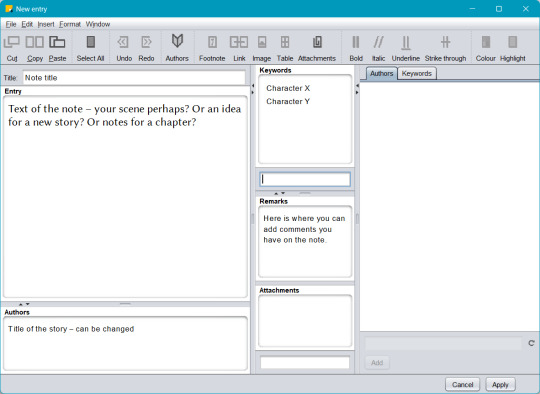
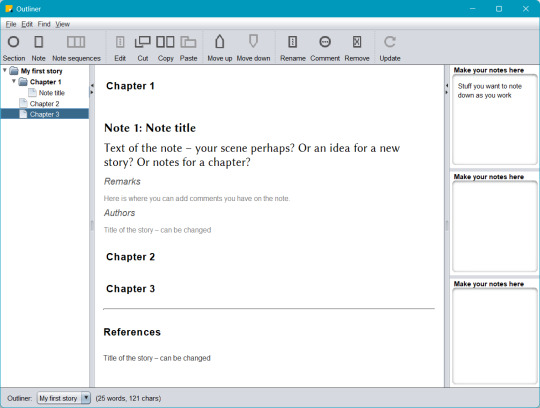
Again, the interface isn’t fancy and may put some people off. I love it exactly because it’s so simple. I want to write, edit and develop my story, not be distracted by something the designers thought would look cool.
So, at least for those of similar simple minds as me, +1 for clarity.
Cost
Zettelkasten is free to download, unlike Scrivener or many other comparable applications. However, as with many a free software application not backed by a company or corporation, it probably has an expiration date and will likely stop working at some point in the future.
Since you can export the whole .zkn3-file to various other formats, you aren’t going to lose anything – in a worst-case scenario (and yes, been there, done that, it works), you can open the .zkn3 file with an archive application like 7zip and extract the underlying .xml-files from there. So no, your stories will not be lost forever just because Zettelkasten stops working. It might just require half an hour’s work to get them out.
Syncing
No cloud storage for Zettelkasten, either. As mentioned here, alternative options include Dropbox, GIT, OneDrive or a regular old USB.
Ease of use for Word/Google doc-users
Again, I really like the uncluttered interface of Zettelkasten, which only has very few buttons. The “write notes first, export later” took a moment to get used to, but was outweighed by the knowledge that I couldn’t lose a note, any note, unless I actively deleted it.
Honestly, that decreased my stress levels significantly. I used Zettelkasten for a long, long time, also for work-related stuff. Once I’d wrapped my brain around the idea of having a note for every idea, I found using it extremly easy and conducive to writing. It wasn’t even a problem when I decided later on that two scenes in two notes should actually be merged – I just put them in the right order on the desk and then deleted the empty line between them when uploading to AO3.
A very long story can take some time to appear on the virtual desk, admittedly, but not once has Zettelkasten crashed on me. My fears of losing ideas and scenes disappeared after I started using it, and I like to believe it even helped me get better at writing, because structuring on the virtual desk made me really think about what was happening in which order.
In short, it is software I can whole-heartedly recommend.
Read No-Google (fan)fic writing, Part 1: LibreOffice Writer
Read No-Google (fan)fic writing, Part 3: LaTeχ
Read No-Google (fan)fic writing, Part 4: Markdown
Read No-Google (fan)fic writing, Part 5: Obsidian
#fic writing#zettelkasten#fanfiction#fanfic writing#degoogle#degoogle your fics#degoogle your writing#software recommendations#resources#no-google (fan)fic writing
23 notes
·
View notes
Note
hi! do you know any good software where i can translate my writing?
Hi! There aren't many I've used myself, but here are a few I found that seem worthwhile.
Translation Software for Writing
Ginger
This isn't solely a translation software (mainly for grammar-checking), but it does have a translate function with over forty languages, as well as a tool that suggests rephrases to make it sound more like the native language (link). There are pricing plants, but at the time of posting this there's a promo on them all.
WhiteSmoke
Another software mainly for grammar, punctuation, style, and spelling, but with a well-developed translator that has 55 languages and a dictionary, thesaurus, and examples showing how a translated word is used in a sentence (link). Currently promo on their plans as well.
Lokalise
This is exclusively a translation software with a function that uses AI to translate "in bulk." It also allows you to collaborate and compare translations with those from other engines. This does have a free option, though its functions are more limited. (link)
Babylon Translator
A straightforward translation tool with over 75 languages and translation services that are both AI-powered and not, as well as dictionaries and glossaries. It also integrates with other software. There’s a free trial in which you can use one dictionary and a limited number of translations you can do. Subscriptions all seem to be annual. (link)
Hope this helped! Happy writing ❤
Previous | Next
#ask#writeblr#writing#writing tips#writing advice#writing help#writing resources#creative writing#writer resources#writing software#writer stuff#deception-united
34 notes
·
View notes